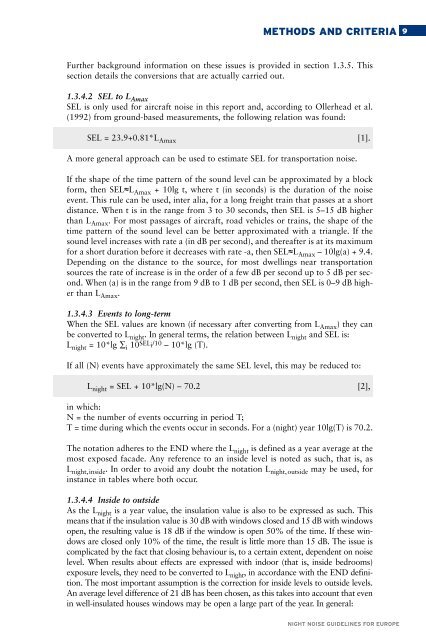Night noise guidelines for Europe - WHO/Europe - World Health ...
Night noise guidelines for Europe - WHO/Europe - World Health ...
Night noise guidelines for Europe - WHO/Europe - World Health ...
You also want an ePaper? Increase the reach of your titles
YUMPU automatically turns print PDFs into web optimized ePapers that Google loves.
METHODS AND CRITERIA 9<br />
Further background in<strong>for</strong>mation on these issues is provided in section 1.3.5. This<br />
section details the conversions that are actually carried out.<br />
1.3.4.2 SEL to L Amax<br />
SEL is only used <strong>for</strong> aircraft <strong>noise</strong> in this report and, according to Ollerhead et al.<br />
(1992) from ground-based measurements, the following relation was found:<br />
SEL = 23.9+0.81*L Amax [1].<br />
A more general approach can be used to estimate SEL <strong>for</strong> transportation <strong>noise</strong>.<br />
If the shape of the time pattern of the sound level can be approximated by a block<br />
<strong>for</strong>m, then SEL≈L Amax + 10lg t, where t (in seconds) is the duration of the <strong>noise</strong><br />
event. This rule can be used, inter alia, <strong>for</strong> a long freight train that passes at a short<br />
distance. When t is in the range from 3 to 30 seconds, then SEL is 5–15 dB higher<br />
than L Amax . For most passages of aircraft, road vehicles or trains, the shape of the<br />
time pattern of the sound level can be better approximated with a triangle. If the<br />
sound level increases with rate a (in dB per second), and thereafter is at its maximum<br />
<strong>for</strong> a short duration be<strong>for</strong>e it decreases with rate -a, then SEL≈L Amax – 10lg(a) + 9.4.<br />
Depending on the distance to the source, <strong>for</strong> most dwellings near transportation<br />
sources the rate of increase is in the order of a few dB per second up to 5 dB per second.<br />
When (a) is in the range from 9 dB to 1 dB per second, then SEL is 0–9 dB higher<br />
than L Amax .<br />
1.3.4.3 Events to long-term<br />
When the SEL values are known (if necessary after converting from L Amax ) they can<br />
be converted to L night . In general terms, the relation between L night and SEL is:<br />
L night = 10*lg ∑ i 10 SEL i /10 – 10*lg (T).<br />
If all (N) events have approximately the same SEL level, this may be reduced to:<br />
L night = SEL + 10*lg(N) – 70.2 [2],<br />
in which:<br />
N = the number of events occurring in period T;<br />
T = time during which the events occur in seconds. For a (night) year 10lg(T) is 70.2.<br />
The notation adheres to the END where the L night is defined as a year average at the<br />
most exposed facade. Any reference to an inside level is noted as such, that is, as<br />
L night,inside . In order to avoid any doubt the notation L night,outside may be used, <strong>for</strong><br />
instance in tables where both occur.<br />
1.3.4.4 Inside to outside<br />
As the L night is a year value, the insulation value is also to be expressed as such. This<br />
means that if the insulation value is 30 dB with windows closed and 15 dB with windows<br />
open, the resulting value is 18 dB if the window is open 50% of the time. If these windows<br />
are closed only 10% of the time, the result is little more than 15 dB. The issue is<br />
complicated by the fact that closing behaviour is, to a certain extent, dependent on <strong>noise</strong><br />
level. When results about effects are expressed with indoor (that is, inside bedrooms)<br />
exposure levels, they need to be converted to L night , in accordance with the END definition.<br />
The most important assumption is the correction <strong>for</strong> inside levels to outside levels.<br />
An average level difference of 21 dB has been chosen, as this takes into account that even<br />
in well-insulated houses windows may be open a large part of the year. In general:<br />
NIGHT NOISE GUIDELINES FOR EUROPE

















